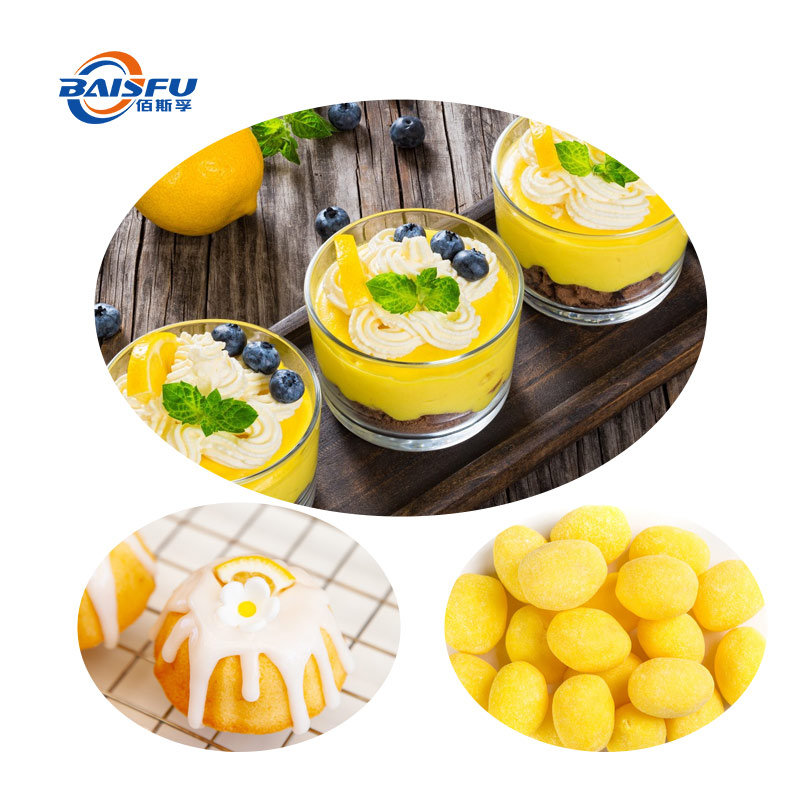Lemon flavor: the "sunshine magician" on the tip of your tongue

1. Four core features of lemon flavor
1. “Instantly light up” sensory explosiveness
The core aroma molecule of lemon flavor can instantly activate the human olfactory receptor OR1A1, triggering the brain’s instinctive perception of “freshness”:
Explosion speed: release aroma within 0.3 seconds (natural lemon juice takes 1-2 seconds to evaporate);
Controllable intensity: 0.01% addition can simulate the aroma of a lemon, and doubling the concentration can create “surreal sourness”.
2. “Unbeatable Warrior” of high temperature and time
High temperature resistance: withstands 220℃ baking and 130℃ sterilization process, and the natural lemon flavor loses 50% at 70℃;
Long-term stability: the aroma retention rate is >85% within the shelf life of 2 years, while natural lemon juice will gradually produce bitterness due to oxidation (naringin hydrolysis).
3. “Transformation Master” compatible across media
Water-soluble: used in beverages and jellies, completely transparent and without precipitation;
Oil-soluble: blended into chocolate coating and cream to avoid water-oil separation;
Powdered: made into effervescent tablets and seasoning salt, portable and precisely controlled.
4. Low cost and environmental innovation
The cost is only 1/100 of fresh lemons: 1kg of lemon flavor ≈ the aroma value of 300 lemons;
Zero waste: avoid water and soil consumption in lemon planting (1,000 tons of water are required to produce 1 ton of lemons).
2. Five major application areas of lemon flavor
1. Beverage industry: “eternal C position” in soda
Carbonated beverages: The “lemon flavor” of Coca-Cola and Sprite is actually flavor blending (natural lemon juice cannot tolerate carbonic acid);
Functional beverages: Sports drinks use lemon flavor to cover up the salty and astringent feeling of electrolytes (such as sodium chloride);
Plant-based beverages: Oatmeal lemon tea uses flavor to neutralize the fishy smell of grains to create a refreshing taste.
2. Baking and desserts: the “balance artist” of sour and sweet
Mousse and cheesecake: flavors replace lemon juice to avoid acidity causing milk protein coagulation;
Frosting and fillings: powdered flavors accurately control the sweet and sour ratio to avoid the natural lemon juice moisture affecting the texture;
Healthy baking: sugar-free cookies use lemon flavors to activate taste buds and make up for the lack of sweetness.
3. Daily chemical cleaning: “sensory tricks” for decontamination
Dishwashing liquid: lemon flavors are combined with surfactants to imply degreasing power with a “fresh feeling” (even if the ingredients are the same, the user satisfaction of lemon-flavored products is increased by 40%);
Air fresheners: neutralize odors through limonene molecules instead of simply covering them;
Skin care products: oil-control cleansers use lemon flavors to create a “refreshing hint”, and the actual cleaning power has nothing to do with the fragrance.
4. Medicine and health: the “sweet disguiser” of bitter medicine
Children’s medicine: mask the bitterness of ibuprofen and vitamin tablets to improve medication compliance;
Disinfectants: add lemon essence to alcohol gel to reduce resistance caused by irritating odors;
Nutritional supplements: use essence to cover the iron smell of protein powder to increase the pleasure of drinking after exercise.
5. Industry and technology: “cross-border experiments” beyond imagination
Car fragrance: car-mounted lemon essence capsules, released through the air conditioning system, refresh and suppress motion sickness;
Emotional healing: VR equipment with essence diffuser, simulate the immersive scene of “Mediterranean lemon garden”;
Agricultural deworming: some organic farms use lemon essence instead of chemical deworming agents.

